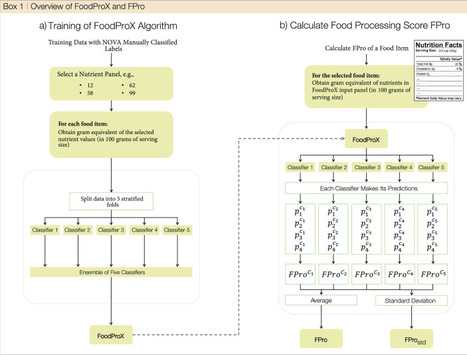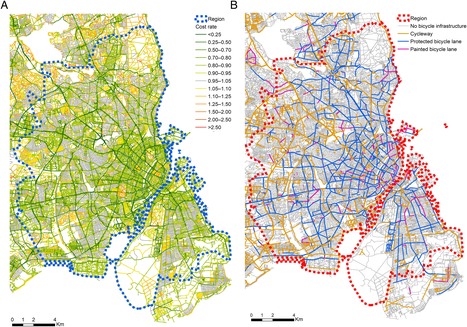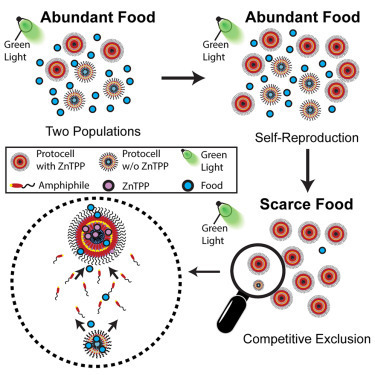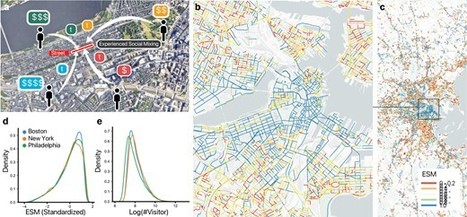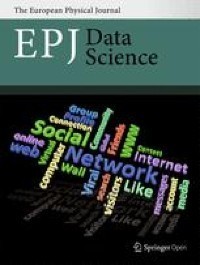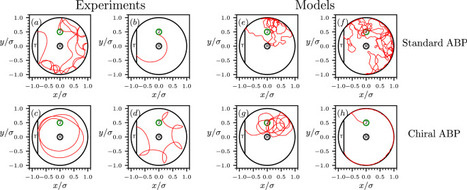 Your new post is loading...
 Your new post is loading...

|
Scooped by
Complexity Digest
April 25, 2023 11:36 AM
|
Giulia Menichetti, Babak Ravandi, Dariush Mozaffarian & Albert-László Barabási
Nature Communications volume 14, Article number: 2312 (2023) Despite the accumulating evidence that increased consumption of ultra-processed food has adverse health implications, it remains difficult to decide what constitutes processed food. Indeed, the current processing-based classification of food has limited coverage and does not differentiate between degrees of processing, hindering consumer choices and slowing research on the health implications of processed food. Here we introduce a machine learning algorithm that accurately predicts the degree of processing for any food, indicating that over 73% of the US food supply is ultra-processed. We show that the increased reliance of an individual’s diet on ultra-processed food correlates with higher risk of metabolic syndrome, diabetes, angina, elevated blood pressure and biological age, and reduces the bio-availability of vitamins. Finally, we find that replacing foods with less processed alternatives can significantly reduce the health implications of ultra-processed food, suggesting that access to information on the degree of processing, currently unavailable to consumers, could improve population health. Read the full article at: www.nature.com

|
Scooped by
Complexity Digest
April 23, 2023 11:49 AM
|
Adam Safron, Dalton A. R. Sakthivadivel, Zahra Sheikhbahaee, Magnus Bein, Adeel Razi and Michael Levin Symmetry is a motif featuring in almost all areas of science. Symmetries appear throughout the natural world, making them particularly important in our quest to understand the structure of the world around us. Symmetries and invariances are often first principles pointing to some lawful description of an observation, with explanations being understood as both ‘satisfying’ and potentially useful in their regularity. The sense of aesthetic beauty accompanying such explanations is reminiscent of our understanding of intelligence in terms of the ability to efficiently predict (or compress) data; indeed, identifying and building on symmetry can offer a particularly elegant description of a physical situation. The study of symmetries is so fundamental to mathematics and physics that one might ask where else it proves useful. This theme issue poses the question: what does the study of symmetry, and symmetry breaking, have to offer for the study of life and the mind? Interface Focus Volume 13 Issue 3 Read the full article at: royalsocietypublishing.org

|
Scooped by
Complexity Digest
April 22, 2023 9:54 AM
|
Pietro Foini, Michele Tizzoni, Giulia Martini, Daniela Paolotti & Elisa Omodei
Scientific Reports volume 13, Article number: 2793 (2023) Food insecurity, defined as the lack of physical or economic access to safe, nutritious and sufficient food, remains one of the main challenges included in the 2030 Agenda for Sustainable Development. Near real-time data on the food insecurity situation collected by international organizations such as the World Food Programme can be crucial to monitor and forecast time trends of insufficient food consumption levels in countries at risk. Here, using food consumption observations in combination with secondary data on conflict, extreme weather events and economic shocks, we build a forecasting model based on gradient boosted regression trees to create predictions on the evolution of insufficient food consumption trends up to 30 days in to the future in 6 countries (Burkina Faso, Cameroon, Mali, Nigeria, Syria and Yemen). Results show that the number of available historical observations is a key element for the forecasting model performance. Among the 6 countries studied in this work, for those with the longest food insecurity time series, that is Syria and Yemen, the proposed forecasting model allows to forecast the prevalence of people with insufficient food consumption up to 30 days into the future with higher accuracy than a naive approach based on the last measured prevalence only. The framework developed in this work could provide decision makers with a tool to assess how the food insecurity situation will evolve in the near future in countries at risk. Results clearly point to the added value of continuous near real-time data collection at sub-national level. Read the full article at: www.nature.com

|
Scooped by
Complexity Digest
April 21, 2023 11:50 AM
|
David C. Krakauer Interface Focus Volume 13 Issue 3 Complex phenomena are made possible when: (i) fundamental physical symmetries are broken and (ii) from the set of broken symmetries historically selected ground states are applied to performing mechanical work and storing adaptive information. Over the course of several decades Philip Anderson enumerated several key principles that can follow from broken symmetry in complex systems. These include emergence, frustrated random functions, autonomy and generalized rigidity. I describe these as the four Anderson Principles all of which are preconditions for the emergence of evolved function. I summarize these ideas and discuss briefly recent extensions that engage with the related concept of functional symmetry breaking, inclusive of information, computation and causality. Read the full article at: royalsocietypublishing.org

|
Scooped by
Complexity Digest
April 19, 2023 11:52 AM
|
Josef Tkadlec, Christian Hilbe, Martin A. Nowak Direct reciprocity is a powerful mechanism for evolution of cooperation based on repeated interactions between the same individuals. But high levels of cooperation evolve only if the benefit-to-cost ratio exceeds a certain threshold that depends on memory length. For the best-explored case of one-round memory, that threshold is two. Here we report that intermediate mutation rates lead to high levels of cooperation, even if the benefit-to-cost ratio is only marginally above one, and even if individuals only use a minimum of past information. This surprising observation is caused by two effects. First, mutation generates diversity which undermines the evolutionary stability of defectors. Second, mutation leads to diverse communities of cooperators that are more resilient than homogeneous ones. This finding is relevant because many real world opportunities for cooperation have small benefit-to-cost ratios, which are between one and two, and we describe how direct reciprocity can attain cooperation in such settings. Our result can be interpreted as showing that diversity, rather than uniformity, promotes evolution of cooperation. Read the full article at: arxiv.org

|
Scooped by
Complexity Digest
April 15, 2023 4:35 PM
|
Louis M. Shekhtman, Alexander J. Gates, Albert-László Barabási While philanthropic support for science has increased in the past decade, there is limited quantitative knowledge about the patterns that characterize it and the mechanisms that drive its distribution. Here, we map philanthropic funding to universities and research institutions based on IRS tax forms from 685,397 non-profit organizations. We identify nearly one million grants supporting institutions involved in science and higher education, finding that in volume and scope, philanthropic funding has grown to become comparable to federal research funding. Yet, distinct from government support, philanthropic funders tend to focus locally, indicating that criteria beyond research excellence play an important role in funding decisions. We also show evidence of persistence, i.e., once a grant-giving relationship begins, it tends to continue in time. Finally, we leverage the bipartite network of supporters and recipients to help us demonstrate the predictive power of the underlying network in foreseeing future funder-recipient relationships. The developed toolset could offer funding recommendations to organizations and help funders diversify their portfolio. We discuss the policy implications of our findings for philanthropic funders, individual researchers, and quantitative understanding of philanthropy. Read the full article at: arxiv.org

|
Scooped by
Complexity Digest
April 13, 2023 4:37 PM
|
Mogens Fosgerau, Mirosława Łukawska, Mads Paulsen, and Thomas Kjær Rasmussen PNAS 120 (16) e2220515120 To what extent is the volume of urban bicycle traffic affected by the provision of bicycle infrastructure? In this study, we exploit a large dataset of GPS trajectories of bicycle trips in combination with a fine-grained representation of the Copenhagen bicycle-relevant network. We apply a model for bicyclists’ choice of route from origin to destination that takes the complete network into account. This enables us to determine bicyclists’ preferences for a range of infrastructure and land-use types. We use the estimated preferences to compute a generalized cost of bicycle travel, which we correlate with the number of bicycle trips across a large number of origin–destination pairs. Simulations suggest that the extensive Copenhagen bicycle lane network has caused the number of bicycle trips and the bicycle kilometers traveled to increase by 60% and 90%, respectively, compared with a counterfactual without the bicycle lane network. This translates into an annual benefit of €0.4M per km of bicycle lane owing to changes in generalized travel cost, health, and accidents. Our results thus strongly support the provision of bicycle infrastructure. Read the full article at: www.pnas.org

|
Scooped by
Complexity Digest
April 12, 2023 11:30 AM
|
Sai Krishna Katla, Chenyu Lin, Juan Pérez-Mercader Cell Reports Physical Science Essential for Darwin’s “struggle for existence,” the competitive exclusion principle (CEP) states that any “two species occupying the same niche will compete with each other to the detriment of one of the species, which will thus be excluded.” Here, we report on competition experiments between two populations of autonomous, artificial, self-booting, self-reproducing polymer-based protocells emerging from a homogeneous blend of small synthetic chemicals in a one-pot reactor using polymerization-induced self-assembly (PISA). These protocells are carbon chemistry based but biochemistry free. The populations share their environment, differing only in that one contains a photocatalyst that confers advantages in reproduction. Competition in the shared environment follows the CEP. Thus, biochemistry is sufficient, not necessary, to drive the CEP. This has implications for protocell research, the origin and early evolution of life, and the laboratory synthesis of life and also relaxes constraints for the potential presence and evolution of generalized life in exoplanets. Read the full article at: www.sciencedirect.com

|
Scooped by
Complexity Digest
April 10, 2023 6:22 PM
|
Klaus Jaffe Classical thermodynamics focused on reversible processes in closed systems. Most processes however are irreversible, in both closed and open systems. A non classical thermodynamics is being developed to tackle complex open systems suffering irreversible processes. That is the case for Synergy that emerges from synchronized reciprocal positive feedback loops between a network of diverse actors. For this process to proceed, compatible information from different sources synchronically coordinates the actions of the actors resulting in a nonlinear increase in the useful work or potential energy the system can manage. In contrast noise is produced when incompatible information is mixed. This synergy produced from the coordination of different agents achieves non-linear gains in free energy and in information (negentropy). Free energy can be estimated by proxies such as individual autonomy of an organism, emancipation from the environment, productivity, efficiency, capacity for flexibility, self-regulation, and self-control of behavior; whereas entropy, or the lack of it, is revealed by the degree of synchronized division of ever more specialized labor, structural complexity, information, and dissipation of energy. Empirical examples that provide quantitative data for these phenomena are presented. Results show that increases in free energy density are concomitant with decreases in entropy density. This may be a rule for synergistic processes in non-equilibrium thermodynamics, which is consilient with the first and second laws of classical thermodynamics. Under this light, biological evolution is the task of self reproducing irreversible synergistic systems to discover empirically (through natural, inclusive, and sexual selection) types of order that increase their free energy. Read the full article at: www.qeios.com

|
Scooped by
Complexity Digest
April 8, 2023 12:05 PM
|
Melanie Mitchell and David C. Krakauer PNAS 120 (13) e2215907120 We survey a current, heated debate in the artificial intelligence (AI) research community on whether large pretrained language models can be said to understand language—and the physical and social situations language encodes—in any humanlike sense. We describe arguments that have been made for and against such understanding and key questions for the broader sciences of intelligence that have arisen in light of these arguments. We contend that an extended science of intelligence can be developed that will provide insight into distinct modes of understanding, their strengths and limitations, and the challenge of integrating diverse forms of cognition. Read the full article at: www.pnas.org

|
Scooped by
Complexity Digest
April 7, 2023 12:02 PM
|
Zhuangyuan Fan, Tianyu Su, Maoran Sun, Ariel Noyman, Fan Zhang, Alex ‘Sandy’ Pentland, Esteban Moro
PNAS Nexus, Volume 2, Issue 4, April 2023, pgad077, Urban density, in the form of residents’ and visitors’ concentration, is long considered to foster diverse exchanges of interpersonal knowledge and skills, which are intrinsic to sustainable human settlements. However, with current urban studies primarily devoted to city- and district-level analyses, we cannot unveil the elemental connection between urban density and diversity. Here we use an anonymized and privacy-enhanced mobile dataset of 0.5 million opted-in users from three metropolitan areas in the United States to show that at the scale of urban streets, density is not the only path to diversity. We represent the diversity of each street with the experienced social mixing (ESM), which describes the chances of people meeting diverse income groups throughout their daily experience. We conduct multiple experiments and show that the concentration of visitors only explains 26% of street-level ESM. However, adjacent amenities, residential diversity, and income level account for 44% of the ESM. Moreover, using longitudinal business data, we show that streets with an increased number of food businesses have seen an increased ESM from 2016 to 2018. Lastly, although streets with more visitors are more likely to have crime, diverse streets tend to have fewer crimes. These findings suggest that cities can leverage many tools beyond density to curate a diverse and safe street experience for people. Read the full article at: academic.oup.com

|
Scooped by
Complexity Digest
April 3, 2023 3:46 PM
|
Thomas Parmer, Luis M. Rocha Given the large size and complexity of most biochemical regulation and signaling networks, there is a non-trivial relationship between the micro-level logic of component interactions and the observed macro-dynamics. Here we address this issue by formalizing the existing concept of pathway modules, which are sequences of state updates that are guaranteed to occur (barring outside interference) in the dynamics of automata networks after the perturbation of a subset of driver nodes. We present a novel algorithm to automatically extract pathway modules from networks and we characterize the interactions that may take place between modules. This methodology uses only the causal logic of individual node variables (micro-dynamics) without the need to compute the dynamical landscape of the networks (macro-dynamics). Specifically, we identify complex modules, which maximize pathway length and require synergy between their components. This allows us to propose a new take on dynamical modularity that partitions complex networks into causal pathways of variables that are guaranteed to transition to specific states given a perturbation to a set of driver nodes. Thus, the same node variable can take part in distinct modules depending on the state it takes. Our measure of dynamical modularity of a network is then inversely proportional to the overlap among complex modules and maximal when complex modules are completely decouplable from one another in the network dynamics. We estimate dynamical modularity for several genetic regulatory networks, including the Drosophila melanogaster segment-polarity network. We discuss how identifying complex modules and the dynamical modularity portrait of networks explains the macro-dynamics of biological networks, such as uncovering the (more or less) decouplable building blocks of emergent computation (or collective behavior) in biochemical regulation and signaling. Read the full article at: arxiv.org

|
Scooped by
Complexity Digest
March 29, 2023 12:36 PM
|
Sandeep Chowdhary, Elsa Andres, Adriana Manna, Luka Blagojević, Leonardo Di Gaetano & Gerardo Iñiguez EPJ Data Science volume 12, Article number: 7 (2023) Human communication, the essence of collective social phenomena ranging from small-scale organizations to worldwide online platforms, features intense reciprocal interactions between members in order to achieve stability, cohesion, and cooperation in social networks. While high levels of reciprocity are well known in aggregated communication data, temporal patterns of reciprocal information exchange have received far less attention. Here we propose measures of reciprocity based on the time ordering of interactions and explore them in data from multiple communication channels, including calls, messaging and social media. By separating each channel into reciprocal and non-reciprocal temporal networks, we find persistent trends that point to the distinct roles of one-to-one exchange versus information broadcast. We implement several null models of communication activity, which identify memory, a higher tendency to repeat interactions with past contacts, as a key source of temporal reciprocity. When adding memory to a model of activity-driven, time-varying networks, we reproduce the levels of temporal reciprocity seen in empirical data. Our work adds to the theoretical understanding of the emergence of reciprocity in human communication systems, hinting at the mechanisms behind the formation of norms in social exchange and large-scale cooperation. Read the full article at: epjdatascience.springeropen.com
|

|
Scooped by
Complexity Digest
April 24, 2023 3:44 PM
|
What was once outright denial has morphed into a subtler dismissal. Read the full article at: www.theatlantic.com

|
Scooped by
Complexity Digest
April 22, 2023 11:51 AM
|
Vincent J Straub, Milena Tsvetkova, and Taha Yasseri Collective Intelligence Humans and other intelligent agents often rely on collective decision making based on an intuition that groups outperform individuals. However, at present, we lack a complete theoretical understanding of when groups perform better. Here, we examine performance in collective decision making in the context of a real-world citizen science task environment in which individuals with manipulated differences in task-relevant training collaborated. We find 1) dyads gradually improve in performance but do not experience a collective benefit compared to individuals in most situations; 2) the cost of coordination to efficiency and speed that results when switching to a dyadic context after training individually is consistently larger than the leverage of having a partner, even if they are expertly trained in that task; and 3) on the most complex tasks having an additional expert in the dyad who is adequately trained improves accuracy. These findings highlight that the extent of training received by an individual, the complexity of the task at hand, and the desired performance indicator are all critical factors that need to be accounted for when weighing up the benefits of collective decision making. Read the full article at: journals.sagepub.com

|
Scooped by
Complexity Digest
April 21, 2023 1:52 PM
|
Josh Bongard
Artificial Life and Robotics (2023) For much of the history of robotics, robots have been built from inert, inorganic, bulk material, such as metals, plastics, and ceramics. However, advances in materials science are driving the development of soft robots made from increasingly exotic but still inorganic materials. Similarly, synthetic biology has recently provided the ability to build ‘biobots’ completely from biological materials. This is driven new use cases for mobile robots, but it is also allowing new questions to be posed about how both body plan and neural control jointly facilitate the evolution of intelligent behavior. Read the full article at: link.springer.com

|
Scooped by
Complexity Digest
April 19, 2023 1:48 PM
|
Jenann Ismael The most immediately salient asymmetry in our experience of the world is the asymmetry of causation. In the last few decades, two developments have shed new light on the asymmetry of causation: clarity in the foundations of statistical mechanics, and the development of the interventionist conception of causation. In this paper, we ask what is the status of the causal arrow, assuming a thermodynamic gradient and the interventionist account of causation? We find that there is an objective asymmetry rooted in the thermodynamic gradient that underwrites the causal asymmetry: along a thermodynamic gradient, interventionist causal pathways—scaffolded intervention-supporting probabilistic relationships between variables—will propagate influence into the future, but not into the past. The reason is that the present macrostate of the world, in the presence of a low entropy boundary condition, will screen off probabilistic correlations to the past. The asymmetry, however, emerges only under the macroscopic coarse-graining and that raises the question of whether the arrow is simply an artefact of the macroscopic lenses through which we see the world. The question is sharpened and an answer proposed. Read the full article at: royalsocietypublishing.org

|
Scooped by
Complexity Digest
April 16, 2023 4:39 PM
|
Do efforts to create life—by cooking up imitations in computers, robots and molecules—point toward a universal definition of biology? Read the full article at: www.scientificamerican.com

|
Scooped by
Complexity Digest
April 13, 2023 6:38 PM
|
Elisa C. Baek, Ryan Hyon, Karina López, Meng Du, Mason A. Porter, Carolyn Parkinson Psychological Science Loneliness is detrimental to well-being and is often accompanied by self-reported feelings of not being understood by other people. What contributes to such feelings in lonely people? We used functional MRI of 66 first-year university students to unobtrusively measure the relative alignment of people’s mental processing of naturalistic stimuli and tested whether lonely people actually process the world in idiosyncratic ways. We found evidence for such idiosyncrasy: Lonely individuals’ neural responses were dissimilar to those of their peers, particularly in regions of the default-mode network in which similar responses have been associated with shared perspectives and subjective understanding. These relationships persisted when we controlled for demographic similarities, objective social isolation, and individuals’ friendships with each other. Our findings raise the possibility that being surrounded by people who see the world differently from oneself, even if one is friends with them, may be a risk factor for loneliness. Read the full article at: journals.sagepub.com

|
Scooped by
Complexity Digest
April 13, 2023 1:20 PM
|
Durt, Christoph and Fuchs, Thomas and Froese, Tom Large language models such as ChatGPT are deep learning architectures trained on immense quantities of text. Their capabilities of producing human-like text are often attributed either to mental capacities or the modeling of such capacities. This paper argues, to the contrary, that because much of meaning is embedded in common patterns of language use, LLMs can model the statistical contours of these usage patterns. We agree with distributional semantics that the statistical relations of a text corpus reflect meaning, but only part of it. Written words are only one part of language use, although an important one as it scaffolds our interactions and mental life. In human language production, preconscious anticipatory processes interact with conscious experience. Human language use constitutes and makes use of given patterns and at the same time constantly rearranges them in a way we compare to the creation of a collage. LLMs do not model sentience or other mental capacities of humans but the common patterns in public language use, clichés and biases included. They thereby highlight the surprising extent to which human language use gives rise to and is guided by patterns. Read the full article at: philsci-archive.pitt.edu

|
Scooped by
Complexity Digest
April 11, 2023 12:00 PM
|
Luigi Zanovello, Richard J. G. Löffler, Michele Caraglio, Thomas Franosch, Martin M. Hanczyc & Pietro Faccioli Scientific Reports volume 13, Article number: 5616 (2023) Artificial cells can be engineered to display dynamics sharing remarkable features in common with the survival behavior of living organisms. In particular, such active systems can respond to stimuli provided by the environment and undertake specific displacements to remain out of equilibrium, e.g. by moving towards regions with higher fuel concentration. In spite of the intense experimental activity aiming at investigating this fascinating behavior, a rigorous definition and characterization of such “survival strategies” from a statistical physics perspective is still missing. In this work, we take a first step in this direction by adapting and applying to active systems the theoretical framework of Transition Path Theory, which was originally introduced to investigate rare thermally activated transitions in passive systems. We perform experiments on camphor disks navigating Petri dishes and perform simulations in the paradigmatic active Brownian particle model to show how the notions of transition probability density and committor function provide the pivotal concepts to identify survival strategies, improve modeling, and obtain and validate experimentally testable predictions. The definition of survival in these artificial systems paves the way to move beyond simple observation and to formally characterize, design and predict complex life-like behaviors. Read the full article at: www.nature.com

|
Scooped by
Complexity Digest
April 9, 2023 9:59 AM
|
Sara Imari Walker Over the short span of just 300 years, since the invention of modern physics, we have gained a deeper understanding of how our universe works on both small and large scales. Yet, physics is still very young and when it comes to using it to explain life, physicists struggle. Even today, we can’t really explain what the difference is between a living lump of matter and a dead one. But my colleagues and I are creating a new physics of life that might soon provide answers. Read the full article at: theconversation.com

|
Scooped by
Complexity Digest
April 8, 2023 10:01 AM
|
Dirk Helbing, Florian Abeillon Since centuries, science has been a collective endeavor to create an increasingly better picture of the world, and scientific indicators have often served as a useful orientation. Recent developments, however, raise the question whether digital platforms create or amplify biases in science? Could this reduce our ability to observe, evaluate and communicate facts objectively? Read the full article at: www.researchgate.net

|
Scooped by
Complexity Digest
April 7, 2023 9:58 AM
|
Carl T. Bergstrom & C. Brandon Ogbunu A better term for this behavior comes from a concept that has nothing to do with medicine, engineering, or technology. When AI chatbots flood the world with false facts, confidently asserted, they’re not breaking down, glitching out, or hallucinating. No, they’re bullshitting. Read the full article at: undark.org

|
Scooped by
Complexity Digest
April 2, 2023 4:44 PM
|
David Smith, Joseph Samuel Myers, Craig S. Kaplan, Chaim Goodman-Strauss A longstanding open problem asks for an aperiodic monotile, also known as an "einstein": a shape that admits tilings of the plane, but never periodic tilings. We answer this problem for topological disk tiles by exhibiting a continuum of combinatorially equivalent aperiodic polygons. We first show that a representative example, the "hat" polykite, can form clusters called "metatiles", for which substitution rules can be defined. Because the metatiles admit tilings of the plane, so too does the hat. We then prove that generic members of our continuum of polygons are aperiodic, through a new kind of geometric incommensurability argument. Separately, we give a combinatorial, computer-assisted proof that the hat must form hierarchical -- and hence aperiodic -- tilings. Read the full article at: arxiv.org
|



 Your new post is loading...
Your new post is loading...

